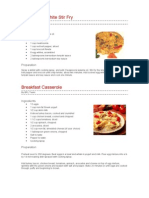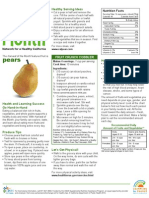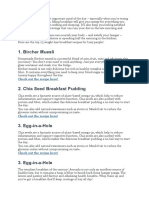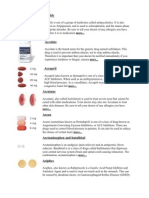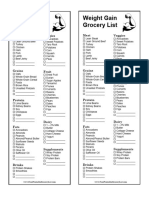All About Carbohydrate Counting
Uploaded by
ionanic72All About Carbohydrate Counting
Uploaded by
ionanic72Toolkit No.
14
All About Carbohydrate Counting
What is carbohydrate counting?
Carbohydrate counting is a way to plan your meals. It
can help you manage your blood glucose (sugar).
Carbohydrates, or carbs, are one of the three main
energy sources in food. The other two are protein and
fat. Its the balance between insulin in your body and
the carbohydrate you eat that determines how much
your blood glucose levels rise after you eat. With the
right balance of carbohydrate and insulin, your blood
glucose level is more likely to stay in your target range.
Counting carbohydrate can help you reach your blood
glucose goals and prevent diabetes complications. You
can learn to count carbs to choose what and how much
to eat. If you take insulin, you can count carbs to
decide how much insulin to take.
Which foods have carbohydrate?
Starchy foods, sugars, fruits, milk, and yogurt are
mostly carbs. See examples in the chart below. These
foods affect your blood glucose much more than other
foods, such as meat and meat substitutes,
vegetables, or fats.
Carbohydrate foods (Carbs)
bread, bagels, biscuits, beans (such as black,
chapatti, muffins,
garbanzo, kidney, lima,
crackers, matzoh, and
navy, or pinto beans),
tortillas
lentils, and peas (such as
black-eyed or split peas)
ready-to-eat cereal or
cooked cereal
barley, bulgur, couscous, fruit (canned, dried,
grits, kasha, pasta, and
fresh, and frozen) and
rice
fruit juice
starchy vegetables such buttermilk, milk, soy
as cassava, corn, peas,
milk, and yogurt
plantains, potatoes, and sweets, such as candy,
winter squash, and sweet cookies, cake, brownies,
potatoes
doughnuts, ice cream,
frozen yogurt, honey,
pancakes and waffles
jam, jelly, pie, pudding,
popcorn, potato chips,
sugar, and syrup
pretzels, and rice cakes
Carbohydrate counting can help you choose what and how
much to eat.
How many grams of carbohydrate are
best for me?
The recommended number of servings is based on your
weight, activity level, diabetes medicines, and goals for
your blood glucose levels. Your dietitian or diabetes
educator, can work with you to make a personalized
plan. A general guideline is to have
45-60 grams of carbohydrate at each meal
15-20 grams of carbohydrate servings at each snack
What about other foods such as meats,
vegetables, and fats?
To have a balanced meal plan, youll want to include
protein foods (such as meat, chicken, and fish),
nonstarchy vegetables (such as salad and broccoli), and
a small amount of healthy fats (such as olive oil and
nuts). Talk with your health care team about what to
eat for your meals and snacks.
Why should I pay attention to serving
sizes for carbohydrate foods?
The amount of carbohydrate you eat can make a big
difference in your blood glucose. If you eat more carbs
than you normally do at a meal, your blood glucose
level is likely to be higher than usual several hours
afterward.
American Diabetes Association 1800DIABETES (3422383) www.diabetes.org
2009 by the American Diabetes Association, Inc. 2/14
Toolkit No. 14: All About Carbohydrate Counting continued
The chart at the bottom of this page shows the size of
1 serving for each food listed. One serving equals
15 grams of carbs. You can check serving sizes with
measuring cups and spoons or a food scale, or by using
the Nutrition Facts label on a food package.
If the total carbohydrate is more than 15 grams, as
in the box in the middle, then divide the total by 15.
For example, a food with 30 grams of carbohydrate
contains 2 carbohydrate servings, because 30 divided
by 15 equals 2.
How to use the Nutrition Facts on food
labels
If the total is less than 15, as in the box on the right,
then multiply the serving size so that your serving
will have 15 grams of carbohydrate.
To decide on a serving size, check the label for the
number of carbohydrate grams (g). One serving is
equal to 15 grams of carbohydrates.
If the total carbohydrate is 15 grams, as in the box
on the left, then check the top of the food label for the
serving size for 1 serving.
Nutrition Facts
Serving Size: 6 crackers
Total Carbohydrate: 15g
One carbohydrate serving is
6 crackers.
How do I get started with carbohydrate
counting?
Ask your health care provider how you can learn more
about carbohydrate counting. You can also get more
information from the American Diabetes Association.
Visit www.diabetes.org, call 1-800-DIABETES
(342-2383), or email [email protected].
Nutrition Facts
Serving Size: 4 cookies
Total Carbohydrate: 30g
One carbohydrate serving is
2 cookies.
Nutrition Facts
Serving Size: 1 graham cracker square
Total Carbohydrate: 5g
One carbohydrate serving is
3 graham cracker squares.
Serving sizes for some carbohydrate foods (each has about 15 grams of carbs)
apple: 1 small (4 ounces)
milk, fat-free or reduced-fat: 1 cup
bagel: large (1 ounce)
orange juice: cup
banana: 1 extra small (4 ounces)
pasta or rice (cooked): cup
bread: 1 slice (1 ounce) or 2 slices reduced calorie
green peas: cup
bread (1 ounces)
cake (unfrosted): 2-inch square
pinto beans or kidney beans (cooked): cup
cereal, unsweeted (ready-to-eat): cup
popcorn (popped): 3 cups
cereal, cooked: cup
potato, mashed: cup
cookies: 2 small (2 inches across)
potato chips: ounce (about 9 to 13)
corn: cup
pretzels: ounce
crackers (saltines): 6
rice: cup
fruit, canned: cup
sugar: 1 tablespoon
hamburger bun: bun (1 ounce)
sweet potato: cup
ice cream (light): cup
taco shells: 2 (5 inches across)
jam or jelly: 1 tablespoon
tortilla, corn or flour: 1 (6 inches across)
Provided By
American Diabetes Association 1800DIABETES (3422383) www.diabetes.org
2009 by the American Diabetes Association, Inc. 2/14
You might also like
- 14 Easiest & Hardest Muscles To Build (Ranked With Solutions)100% (7)14 Easiest & Hardest Muscles To Build (Ranked With Solutions)27 pages
- Assignment ON Diabetic Diet: Submitted To: Ms. Sarita Nadiya86% (7)Assignment ON Diabetic Diet: Submitted To: Ms. Sarita Nadiya8 pages
- 0 Weight Loss Tips To Make Things Easier (And Faster) : High-Protein Breakfast 16trusted Source 17trusted Source100% (1)0 Weight Loss Tips To Make Things Easier (And Faster) : High-Protein Breakfast 16trusted Source 17trusted Source2 pages
- Nutrients and Health Benefits Veg - Choose MyPlateNo ratings yetNutrients and Health Benefits Veg - Choose MyPlate1 page
- Heart Healthy Diet: Low Fat, Low Cholesterol, Low Sodium DietNo ratings yetHeart Healthy Diet: Low Fat, Low Cholesterol, Low Sodium Diet11 pages
- The Skinny Buddha Weight Loss Method: by Dr. Wu Tao-Wei100% (1)The Skinny Buddha Weight Loss Method: by Dr. Wu Tao-Wei20 pages
- How To Gain Weight in A Week 9 Experts Suggested Tips100% (1)How To Gain Weight in A Week 9 Experts Suggested Tips11 pages
- Applied Military Physiology by Wennblom and TerzicNo ratings yetApplied Military Physiology by Wennblom and Terzic53 pages
- Personalized Keto Diet Meal Plans KetoCycle - DietNo ratings yetPersonalized Keto Diet Meal Plans KetoCycle - Diet1 page
- Family Is A Fundamental Social Group in Society Typically Consisting ofNo ratings yetFamily Is A Fundamental Social Group in Society Typically Consisting of1 page
- PDF Version of This Guide That You Can Download Here!: Fat Fast100% (1)PDF Version of This Guide That You Can Download Here!: Fat Fast14 pages
- Shoulder - Rotator Cuff Pain: Are You Feeling Any of The Following?No ratings yetShoulder - Rotator Cuff Pain: Are You Feeling Any of The Following?4 pages
- The Skeletal System: Answer The Following Questions0% (1)The Skeletal System: Answer The Following Questions2 pages
- Cardiopulmonary Exercise Testing: Mitchell HorowitzNo ratings yetCardiopulmonary Exercise Testing: Mitchell Horowitz43 pages
- Ieri Activities 2012-2013: European Institute For International Relations Ieri-GlobeNo ratings yetIeri Activities 2012-2013: European Institute For International Relations Ieri-Globe5 pages



